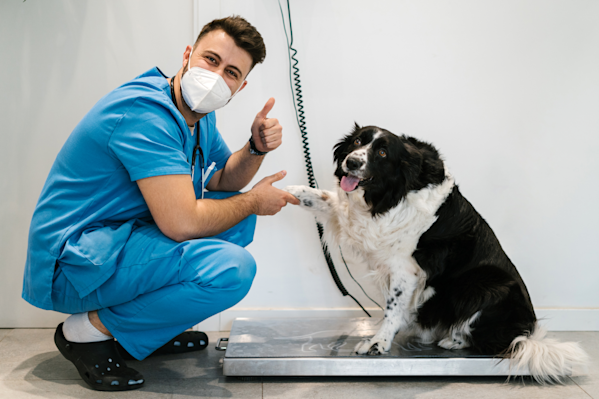If your pup has packed on a few pounds, it’s probably a good time to make an appointment with your vet and figure out how to help them lose weight safely, as dogs who are overweight have a shorter and lower quality of life than pups who aren’t obese.
Obese pets are unfortunately much more likely to get ailments related to their weight gain, such as Type 2 diabetes, heart disease, arthritis, and even some forms of cancer. Obesity also affects a dog’s day-to-day quality of life, so if your vet diagnoses your furry friend as being overweight and there’s no underlying cause for their weight gain, it’s important to make some changes to their diet and lifestyle, as that’s the only safe and effective way to get them to lose the extra pounds.
“There are no medications to help them reach their ideal weight, or at least none that I can safely recommend,” says Dr. Yui Shapard. “Unless the cause of the bodyweight is due to a metabolic illness like hypothyroidism, the best path to a healthy weight is through the tried and tested path of diet and lifestyle change.”
Read on for a breakdown of how to help your dog lose weight safely through these two methods. And of course, the experts at Pawp are here 24/7 to address any specific questions or concerns you may have about your dog’s weight or anything else.
How to help my dog lose weight safely
Any weight loss plan you implement for your pup should be done with oversight from your veterinarian. The first way to help your dog lose weight is through diet changes.
Diet
A veterinarian will be able to determine the kind and amount of food your dog should have based on your pup’s health status, age, activity level, and spay or neuter status.
One thing that vets will almost always recommend, however, is to stop feeding your furry friend human food or treats.
“This is the most common cause of dog obesity,” explains Dr. Shapard. “There are some healthy treats available, but even then, if you exceed your dog's daily calorie intake, your dog can still become overweight or obese.”
As for your dog's food, your vet may prescribe a prescription weight loss food or recommend a brand that offers a product focused on weight loss. Your vet can also let you know how much food your pup should have based on their target caloric intake. The amount of calories your dog should have can vary significantly depending on the specific condition of your pup, which is why working with a vet who knows your dog’s health details is so important.
Lifestyle
The other thing you can do to help your dog lose weight is increasing your pup’s activity level.
“Increasing outdoor playtime or playing a game of fetch inside are great ways for your dog to become more active,” says Dr. Shapard. “You can go on longer walks if the temperature is not extreme, or if your dog is a naturally athletic breed, you can consider taking them on a short run with you.”
Dr. Shapard also cautions that previously inactive pups will not be able to go on long runs at the beginning.
“Start with a short and sweet session,” she recommends. “As they start to lose the weight and their energy returns to how it should be, then you can increase playtime as well.”
You can also make some changes at home to encourage your pup to be more active. If you have more than one floor, for example, you could try putting their food on the second floor so they have to go up the stairs to eat. You can also buy some new dog toys—like a laser pointer or toys that move on their own—to try to get your pup more interested in moving.
The process to help your pup be the healthiest weight they can be is a gradual one, as vets do not want their patients to lose more than 2% of their body weight in a given week. To that end, it’s important to check your dog’s weight regularly and also have routine check-ins with your vet to monitor your pup’s progress and make any adjustments as needed.
Over time, implementing diet changes and gradually increasing the amount of exercise your dog gets should help get them back to a weight that will keep them healthy and happy.
Have questions about how to help your dog lose weight safely? The vet team at Pawp is here to help 24/7.
